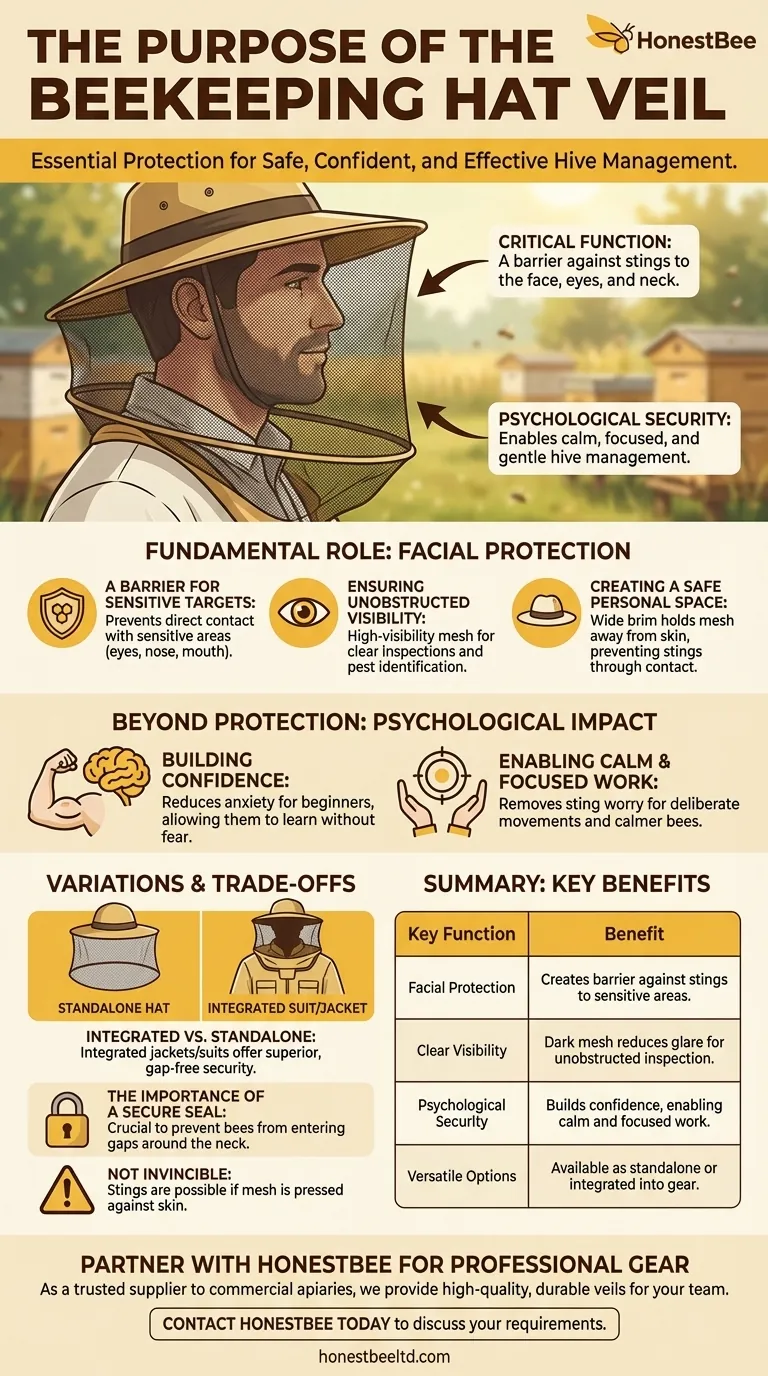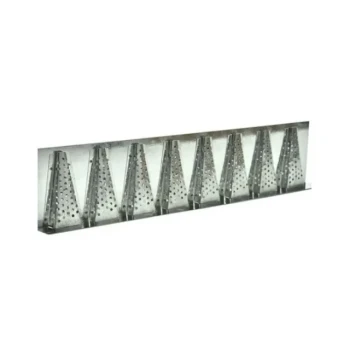At its core, a beekeeping hat veil serves one critical function: to provide an essential barrier that protects your face, eyes, and neck from bee stings. This simple piece of equipment consists of a wide-brimmed hat and a see-through mesh that drapes over your head and rests on your shoulders, allowing you to work safely and with a clear line of sight. It is widely considered the absolute minimum piece of protective gear for any beekeeper.
The purpose of the veil extends beyond just preventing pain. Its true value lies in providing the psychological security necessary for a beekeeper to remain calm, focused, and gentle, leading to more effective hive management and a safer experience for both the keeper and the bees.

The Fundamental Role of Facial Protection
Bees often target the face when they feel threatened, making facial protection a non-negotiable aspect of apiary safety. The veil is your first and most important line of defense against this defensive behavior.
A Barrier for a Sensitive Target
The veil creates a physical barrier between you and the bees. This prevents them from making direct contact with your skin, particularly sensitive areas like your eyes, nose, and mouth, which are common targets for stings.
Ensuring Unobstructed Visibility
A well-designed veil uses high-visibility mesh, typically in a dark color to reduce glare. This critical feature allows you to see clearly, enabling you to inspect the hive, identify the queen, and spot signs of disease or pests without impairment.
Creating a Safe Personal Space
The wide brim of the hat is designed to hold the mesh away from your face. This prevents the veil from resting against your skin, which would otherwise allow a determined bee to sting through the mesh.
Beyond Protection: The Psychological Impact
The most significant benefit of a veil is the confidence it provides. By removing the immediate threat of a facial sting, it allows a beekeeper to perform their work more effectively and thoughtfully.
Building Confidence for Beginners
For new beekeepers, the veil is indispensable. It allows them to learn bee behavior and practice hive inspections with confidence, reducing the anxiety that can lead to clumsy movements and agitated bees.
Enabling Calm and Focused Work
When you aren't worried about being stung in the face, you can focus entirely on the task at hand. This calm focus translates into smoother, more deliberate movements, which in turn keeps the bee colony calmer and less defensive.
Understanding the Trade-offs and Variations
While the principle is simple, not all veils are created equal. The type of veil you choose is often integrated with other protective gear, offering different levels of security.
Standalone Hat vs. Integrated Veils
A simple hat and veil is the most basic option. For more complete protection, many beekeepers prefer a jacket or a full-body suit with a veil built directly into the collar. This integrated design eliminates gaps where bees could potentially enter.
The Importance of a Secure Seal
Regardless of the style, the most common point of failure is where the veil meets the body. Ensuring there are no gaps around your neck or collar is crucial for preventing a bee from crawling inside your protective space.
The Illusion of Complete Invincibility
A veil provides exceptional protection, but it is not infallible. It is still possible for a bee to sting through the mesh if it is pressed directly against your skin. The veil is a tool that enables safe practice, not a replacement for it.
Making the Right Choice for Your Goal
Selecting the right level of protection depends on your comfort level, the temperament of your bees, and the intensity of the work you plan to do.
- If your primary focus is occasional hive checks with a calm colony: A simple, well-designed hat and veil provides the essential minimum protection required.
- If your primary focus is building confidence as a new beekeeper: An integrated jacket with a built-in veil offers superior security and greater peace of mind.
- If your primary focus is maximum safety for extensive hive work: A full-body beekeeping suit with an integrated veil provides the most comprehensive defense available.
Ultimately, the right veil empowers you to be a more observant, confident, and effective beekeeper.
Summary Table:
| Key Function | Benefit |
|---|---|
| Facial Protection | Creates a barrier against stings to sensitive areas like eyes and mouth. |
| Clear Visibility | Dark mesh reduces glare for unobstructed hive inspection. |
| Psychological Security | Builds confidence, enabling calm and focused work. |
| Versatile Options | Available as a standalone hat or integrated into suits/jackets. |
Ready to work with your bees confidently and safely?
As a trusted supplier to commercial apiaries and beekeeping equipment distributors, HONESTBEE provides high-quality, durable beekeeping hat veils and protective gear designed for professional use. Our wholesale-focused operations ensure you get the reliable equipment you need to protect your team and manage your hives effectively.
Contact HONESTBEE today to discuss your protective gear requirements and discover how our products can enhance safety and efficiency in your operation.
Visual Guide

Related Products
- Beekeeping Gloves Goatskin Leather with Long Cotton Sleeve for Beekeepers
- Mesh Ventilated 3 Layer Goatskin Beekeepers Gloves for Beekeeping
- Professional Galvanized Hive Strap with Secure Locking Buckle for Beekeeping
- 8-Cone Galvanized Steel Bee Robber Guard
- Heavy Duty Stainless Steel Queen Bee Catcher Clip
People Also Ask
- Why do some experienced beekeepers choose not to wear gloves? For Superior Dexterity & Hive Welfare
- What are the advantages of goatskin leather gloves for beekeeping? Superior Sting Protection for Your Apiary
- Should beekeepers wear gloves, and why? Essential Protection for Beekeepers
- What is the safest way to handle frames in beekeeping? Master Gentle Handling for a Calm Hive
- Why are protective gloves important in beekeeping? Boost Confidence & Safety in Your Apiary



















